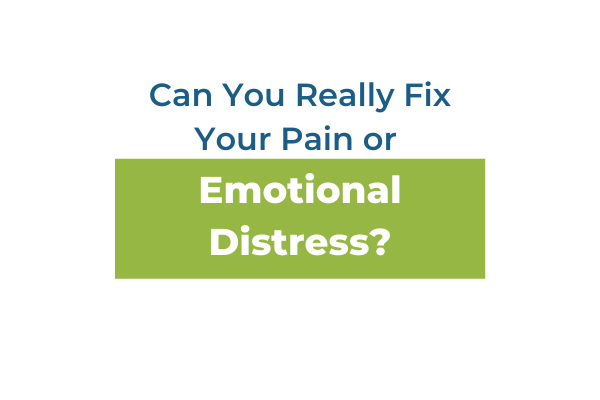
How Do I Fix This Pain or Emotional Distress?
We’re around half way through the Inner Healng Mastery™ course and many are asking the question, “Doc, how do I fix or change this persistent physical or emotional pain or negative thought pattern that I keep experiencing?” We all experience this issue. And it always comes up in class at some point.
It’s a natural question to ask, “How do I fix this problem”.
But it’s the wrong question to ask.
Trying to “fix” inner pain and suffering usually makes it worse.
That doesn’t mean you’re going to suffer forever.
But we’re talking about inner transformation.
Fixing is the wrong outlook.
Inner Transformation is about healing.
Healing comes from a deeper place than the part of you that wants to fix it.
What’s Wrong with Trying to Fix Myself?
When I’m trying to fix something, I’m confronting it as if I’m going to make it change according to my will.
That “will to fix” is an agenda. There’s a part of all of us that doesn’t want to tolerate unpleasantness. We want to push away the pain. And usually when we try to push something away, we unknowingly pull it close to us.
My need to fix myself is usually coming from a place of fear, or anger, or sadness or other negative mind state. I have an issue with the issue that’s bothering me. I’m scared that I’m angry or I’m angry that I’m scared. When I take the desire to fix, which is rooted in a sense of brokenness and suffering, and push and pound on another aspect of my body-mind suffering, I create more noise, more tension, more pressure, more suffering.
It’s like two unhappy kids in the classroom. Bobby is convinced that Richie is doing something bad, so he starts to shoot spitballs at him or make fun of him or argue with him and maybe push him around. But Bobby is acting out his own aggression and unhappiness. So they create a bunch of noise and turmoil, and everyone in the room is affected by it.
It’s a simple metaphor. But there are actually good reasons why this is true, that are starting to be clarified by neuroscience. And it fits the map of our consciousness discussed by our sages, that they shared to help us transform our baser nature into something that is generous, kind, loving, and holy.
But lets keep this practical.
The main thing is I invite you to think differently.
To get out of ‘fixing’ mode and into healing mode.
Drop The Fixing Agenda and Rest Into Healing
I invite you to think and feel like a enlightened teacher in the classroom rather than two students pushing each other around. The enlightened teacher is not invested in the drama. The teacher is able to bring his caring and maturity. He understands the children and their needs. He intuits the root of their misbehavior. He creates boundaries for them, and nourishes them emotionally. So they become harmonious. He helps them grow up.
This fits well with the work of the Inner Healing Mastery course. We started by practicing being present to the flow of experience, including our unpleasant experiences. We are focussing on developing mindfulness, which lets us be with ourselves and start to see whats really happening.
There are three main steps that we are learning. 1. Naming the experience, 2. distinguishing the physical, emotional, and cognitive parts of the experience, and 3. acknowledging and agreeing to its existence in the moment.
The Power of Naming
First lets talk about naming or labeling the issue.
When we label the emotional tone of the thing, it’s often helpful to use one of three choices: pleasant, unpleasant, and neutral. If it’s pain or suffering, it can be helpful to name it as “unpleasant”. It’s a fairly uncharged word. It accurately describes pain, but it gives room for the pain to evolve. If I label something “horrible pain” or “intolerable” then I’m already activating circuits of suffering in my brain. We want to relate to it with acceptance and love like the enlightened teacher. So name it ‘unpleasant sensation’
The Power of Making Distinctions
Then I want to distinguish the physical sensation, from the emotions arising, and the thoughts and stories and judgments that are arising.
If there is physical pain I notice it’s qualities. Intense sensation. Unpleasant. Sharp, or dull or tingling or numb. It’s location. It’s shape. Noticing it and staying anchored in my breathing.
Sometimes there are emotions connected to the physical feeling. Perhaps I first just feel pain, but I ask ‘what emotion am I feeling?’ and I see that its fear (or anger, or whatever I am experiencing). Yes and there is also sadness. So I acknowledge and welcome the fear and sadness. I accept that this is what’s happening.
Sometimes there are all kinds of stories, judgements, rationalizations, explanations. “I’ll never get better. It’s all her fault. It’s all my fault. This is intolerable. I can’t live like this” These are judgements and stories that are often generated by my emotions. They are usually about the future and past. We want to relate to the reality of what’s happening in the present. So I acknowledge the thoughts, I name them ‘thinking’ or ‘judging’ or ‘catastrophizing’ and let them go. They may come back. But I don’t invest in them or hold on to them. And I don’t try to push them away. Like clouds on a sunny day I observe them while I stay anchored in my breathing or other pleasant present-moment experience.
When I make those distinctions, I’m getting more clear on what is really happening. What may have been a sense of overwhelming chaos and storm becomes a more clear understanding of the aspects of the suffering. I start to see cause and effect. I can see the stories and judgements that keep me from healing. it helps me see what is true and what is false. What is useful and what is counterproductive. It empowers me to let go of what is not serving me, and to bring compassion and forgiveness to the parts that need it. I’m giving myself options for how to work constructively with the situation.
Accept, Agree, and Be
So after acknowledging and labeling, and distinguishing the physical, emotional, and cognitive parts, agree with the experience. You could also use the word “accept’.
That doesn’t mean agree that it’s going to be forever. Agree that its what is happening now. Because it is what’s happening now. And I have no idea what the future is going to bring. So staying with the now. “I agree that I am experiencing unpleasant sensation and emotion and mind states, now.”
When I agree, I’m dropping my agenda. I’m dropping the cruel pressure to make things different than they are, The pressure to fix things, that we almost reflexively add when we react to something that hurts. In the metaphor of the classroom, the agenda to fix is like Bobby, the other kid in the class, whose irritated by Richie’s pain. Bobby doesn’t have much skill, and he wants to come in and force Richie to shut up, and thus feeds the chaos and noise. When I agree with my experience, I disengage my resistance. I stop interpreting my experience. I let go the tendency to develop drama and other emotions about my experience. I’m dis-indentifying from the fighting children, and identifying with the role of enlightened teacher.
While doing these three steps, we sit and stay anchored in some pleasant experience like our breathing or sense of the body, and we give that unpleasant experience some but not all of our attention, and we wait.
To sum up, when I do these steps of acknowledging, distinguishing, and agreeing, I’m shining light into the experience of suffering. I’m unpacking it without emotional charge. When it is unconscious, the suffering is a vicious cycle of ripples in the integrated emotion/though/body system. When I shine the light of my consciousness into it, I’m uncoupling or disconnecting the reactive parts of the vicious cycle. I’m making space for something else to happen.
Watching the Flow of the River of Life
We shared a metaphor of the stream of life experience flowing along. And the practice of working with difficult experiences is to sit on the bank of the river, to be anchored on the bank of the river, while being aware of the river of unpleasant or pleasant experiences flowing past. So when an unpleasant emotion or physical sensation comes along, we note it, acknowledge it, but stay anchored on the bank of the river, by attaching to our breathing and present-moment awareness.
We try not to get sucked into the river. That means we don’t give the unpleasant experience too much of our attention. We don’t get emotionally activated by it. We notice that it’s happening. We care about the suffering with compassion, like caring for small child is crying. We agree to its existence, because here it is. But we don’t dive into it.
Sometimes we fall into the river. It happens. We get sucked in emotionally. Or we are staring at the pain our shoulder and wanting it to change, so we generate a bunch of muscle tension and the physical pain gets worse. So sometimes our old habits win and we fall in. And hopefully we forgive ourselves for being human and climb out maybe go for a walk and dry off. And then we sit back down on the bank of the river.
Activating The Power of the Heart and Soul
More recently in the course we’ve started generating positive mind-heart states. For instance, we started a practice where we find and generate a heart-full intention for the good of myself or another person. And I meditate on the intention and develop a heart-full energy of lovingkindness. It can be a very pleasant experience.
Soon we’ll also work with generating and developing a felt sense of connection to the Source of Life, or G!d if you are comfortable with that language.
Whether its a heart-full good intention, or a more spiritual sense of possibility, intention, and connection to G!d, what we are creating is a another kind of anchor. It’s another kind of ‘riverbank’ that we can attach ourselves to. We bring a positive, loving, energy of possibility and joy and sit in it, while we are also aware of that difficult emotional/physical/mental state.
So we take the three steps of labeling, distinguishing and agreeing while being present to them and turn on the high beams. When we connect to a higher state of heart-mind, it’s kind of like taking the 3rd step of “agreeing” and energizing it with sweetness and love.
Said differently, when I access a connected living mindbody state, I generate biochemistry of healing. I connect to an energetically charged integrated mind-body-emotion state, and also give some attention to the pain. I sweeten the pain and start to transform it.
The main thing is to practice.
To notice and label the experience as unpleasant
To distinguish it’s physical, emotional, and mental manifestations,
To agree to the reality of its existence in this moment
And to anchor ourselves gently and confidently in a state of heart/mind that is open, stable, receptive, loving, and sweet.
To give some attention to the existence of the difficult body-mind state, but not too much. Being aware that it’s there, while we rest into a place of of pleasantness.
And see what happens.
I encourage you to keep practicing.
Please comment and share this post.

